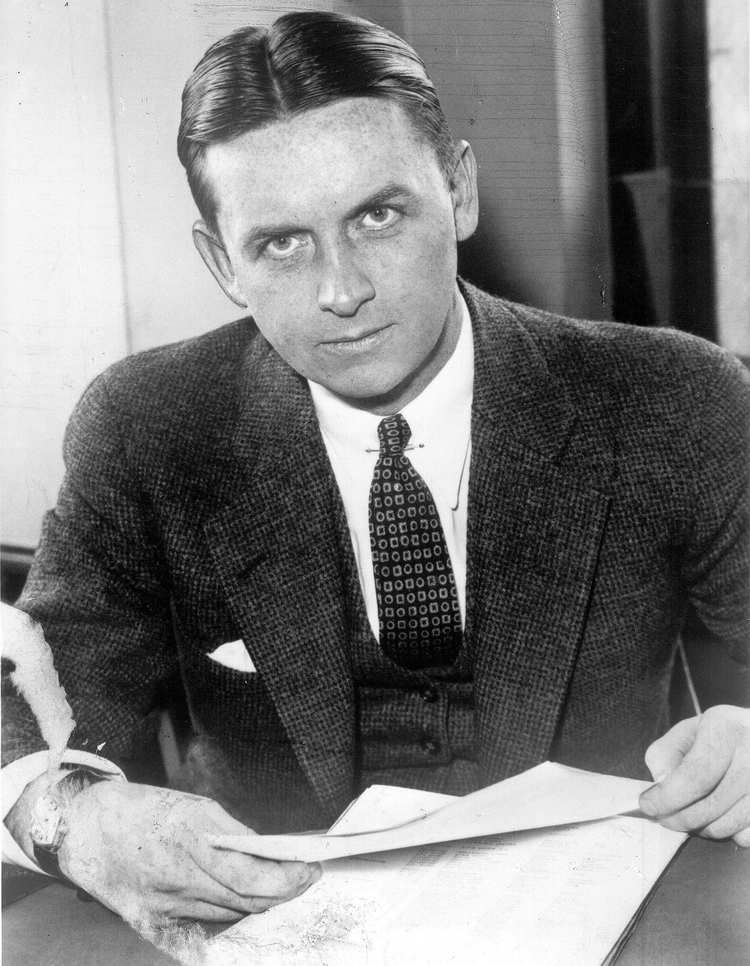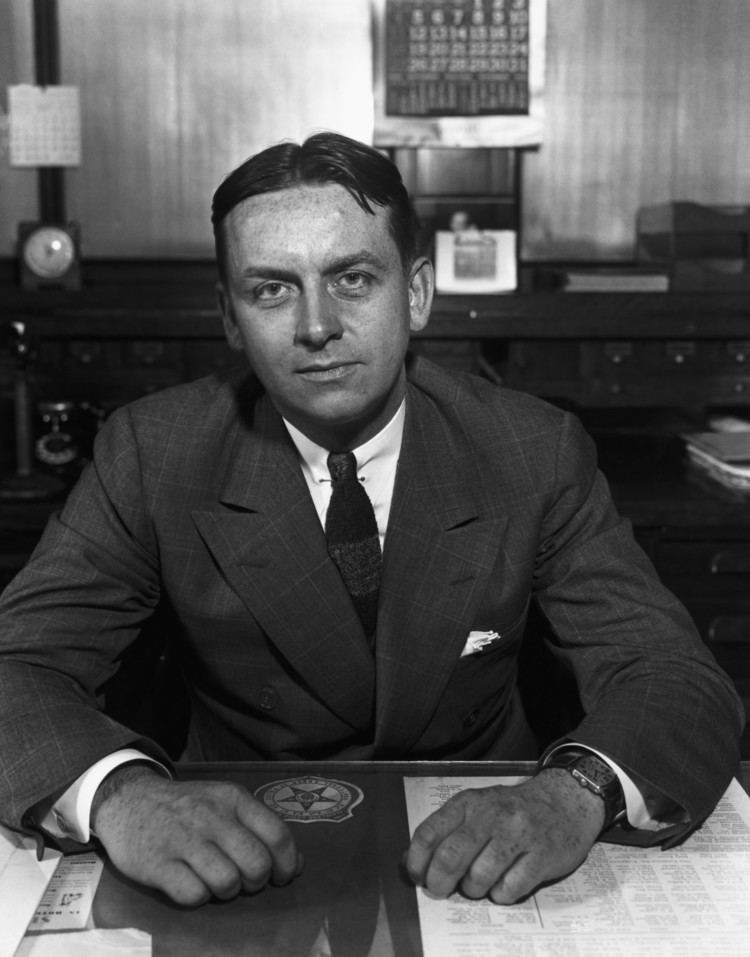Name Eliot Ness Children Robert Ness | Role Special agent | |
 | ||
Spouse Betty Anderson Seaver (m. 1946–1957), Evaline McAndrew (m. 1939–1945), Edna Staley (m. 1929–1938) Similar People | ||
Biography eliot ness untouchable michael husain
Eliot Ness (April 19, 1903 – May 16, 1957) was an American Prohibition agent, famous for his efforts to enforce Prohibition in Chicago, Illinois, bringing down Al Capone, and the leader of a famous team of law enforcement agents nicknamed The Untouchables. His co-authorship of a popular autobiography, The Untouchables, which was released shortly after his death, launched several television and motion picture portrayals that established Ness's posthumous fame as an incorruptible crime fighter.
Contents
- Biography eliot ness untouchable michael husain
- BRAVENORTH4BOOKtvTheUntouchablesflip10secmov
- Early life
- 19271931
- 19311957
- Later life
- Personal life
- Death
- Archive
- Art entertainment and media
- Beer
- Proposed building naming
- References
BRAVE_NORTH_4_BOOKtv_The_Untouchables_flip_10sec.mov
Early life

Eliot Ness was born on April 19, 1903, in Chicago, Illinois. He was the youngest of five children born to Peter Ness (1850–1931) and Emma (King) Ness (1863–1937). His parents, both of whom were Norwegian immigrants, operated a bakery. Ness attended Christian Fenger High School in Chicago. He was educated at the University of Chicago, graduating in 1925 with a degree in economics. He began his career as an investigator for the Retail Credit Company of Atlanta. He was assigned to the Chicago territory, where he conducted background investigations for the purpose of credit information. He returned to the University to take a course in criminology, eventually earning a master's degree in the field.
1927–1931

In 1926, Ness's brother-in-law, Alexander Jamie, an agent of the Bureau of Investigation (which later became the Federal Bureau of Investigation in 1935), influenced Ness to enter law enforcement. He joined the U.S. Treasury Department in 1927, working with the 1,000-strong Bureau of Prohibition in Chicago.

Following the election of President Herbert Hoover, U.S. Treasury Secretary Andrew Mellon was specifically charged with bringing down gangster Al Capone. The federal government pursued his illegal activities in two areas: income tax evasion and violations of Prohibition. Ness was chosen to head the operations under the National Prohibition Act (informally known as the Volstead Act), targeting the illegal breweries and supply routes of Capone.

With corruption of Chicago's law enforcement agents epidemic, in 1929 Ness went through the records of all Prohibition agents to create a reliable team (initially of 50, later reduced to 15, and finally to just 11 men) called "The Untouchables." Raids against illegal stills and breweries began immediately; within six months Ness claimed to have seized breweries worth over one million dollars. The main source of information for the raids was an extensive wire-tapping operation. An attempt by Capone to bribe Ness's agents was seized on by Ness for publicity, leading to the media nickname "The Untouchables." Although Ness was not attacked, one of his close friends was killed.
The efforts of Ness and his team brought major damage to Capone's operations. Ness's efforts eventually led the IRS to prosecute Capone for income tax evasion, according to Ness, although in reality the Capone tax trial was a result solely of the research work done under the aegis of U.S. Attorney George E.Q. Johnson and IRS agent Frank Wilson whose investigations led to Capone's downfall. In a number of federal grand jury cases in 1931, Capone was charged with 22 counts of tax evasion and also 5,000 violations of the Volstead Act. On October 17, 1931, Capone was convicted on five of the tax evasion charges, after the Volstead Act violations were dropped. He was sentenced to 11 years in prison and, following a failed appeal, began his sentence in 1932.
1931–1957
Ness was promoted to Chief Investigator of the Prohibition Bureau for Chicago and in 1934 for Ohio. Following the end of Prohibition in 1933, he was assigned as an alcohol tax agent in the "Moonshine Mountains" of southern Ohio, Kentucky, and Tennessee, and in 1934 he was transferred to Cleveland, Ohio. In December 1935, Cleveland mayor Harold Burton hired him as the city's Safety Director, which put him in charge of both the police and fire departments. He headed a campaign to clean out police corruption and to modernize the fire department.
In 1938, Ness and his wife Edna divorced. He declared war on the mob, and his primary targets included "Big" Angelo Lonardo, "Little" Angelo Scirrca, Moe Dalitz, John Angerola, George Angersola, and Charles Pollizi. Ness was also Safety Director at the time of several grisly murders that occurred in the Cleveland area from 1935 to 1938 and made relatively small efforts during the investigations. His otherwise remarkably successful career in Cleveland withered gradually. Cleveland critics targeted his divorce, his high-profile social drinking and his conduct in a car accident, but he continued with the next Mayor, Frank Lausche.
In 1939 Ness married illustrator Evaline Michelow. In 1942 the Nesses moved to Washington, D.C., where he worked for the federal government. He directed the battle against prostitution in communities surrounding military bases, where venereal disease was a serious problem. Later he made a number of forays into the corporate world, all of which failed owing to his lack of business acumen. In 1944, he left to become chairman of the Diebold Corporation, a security safe company based in Ohio.
After his second divorce and third marriage, he ran unsuccessfully for Mayor of Cleveland in 1947, after which he was expelled from Diebold in 1951. In the aftermath, Ness began drinking more heavily and spending his free time in bars telling (often exaggerated) stories of his law enforcement career. He also spent himself into debt. Ness was forced into taking various odd jobs to earn a living, including electronics parts wholesaler, clerk in a bookstore, and salesman of frozen hamburger patties to restaurants. By 1953 he came to work for an upstart company called Guaranty Paper Corporation, which specialized in watermarking legal and official documents to prevent counterfeiting. Ness was offered a job because of his expertise in law enforcement. The company soon moved from Cleveland to the quiet rural town of Coudersport, Pennsylvania, where operating costs were lower. He made a decent income from GPC and moved with his wife and adopted son into a modest rental house. Once again, he enjoyed going to local bars and regaling amazed audiences with his tales of crime fighting.
Later life
Al Capone promised Ness that two $1,000 notes would be on his desk every Monday morning if he turned a blind eye to Capone's bootlegging activities (roughly $29,000 a week in today's money). Ness refused the bribe and in later years struggled with money; he died almost broke at the age of 54. Ness and his role in bringing down Al Capone had been largely forgotten at the time of his death in 1957, and no Chicago newspaper carried news of Ness's death. His heroic reputation only began with the posthumous publication of the 1957 book he had co-written with Oscar Fraley and the 1959 and 1993 television series, 1987 film, and related media adapted from it.
Personal life
Ness was married to Edna Staley from 1929 to 1938, illustrator Evaline Michelow (1911–1986) from 1939 to 1945, and artist Elisabeth Andersen Seaver (1906–1977) from 1946 until his death in 1957. He also had an adopted son, Robert (1946–1976).
Death
Ness collapsed and died at his home in Coudersport, Pennsylvania, of a massive heart attack on May 16, 1957; he was 54. His ashes were scattered in one of the small ponds on the grounds of Lake View Cemetery in Cleveland. He was survived by his widow, Elisabeth Andersen Seaver, and adopted son, Robert.
Archive
The Western Reserve Historical Society houses additional Ness papers, including a scrapbook (1928–1936), copies of newspaper clippings (1935–1950), a typewritten manuscript detailing Ness's career in Chicago, and miscellaneous papers, including a report on the Fidelity Check Corporation and Guaranty Paper, of which Ness was president.
Art, entertainment, and media
Numerous media works have been developed based on Eliot Ness's life and the legend surrounding his work in Chicago. The first of these resulted in Ness's last years from his collaboration with Oscar Fraley in writing the book The Untouchables (1957), which was published a month after Ness's death and went on to sell 1.5 million copies. This book, among Fraley's other books about the Untouchables, was heavily spiced with fiction, including fictional characters and events, to make the books more appealing to a general audience. The 21-page manuscript that Ness wrote for the book was a more trustworthy source and only included the real events that Ness experienced during his career. His manuscript is housed in the archives of the Western Reserve Historical Society in Cleveland, Ohio.
The book was adapted in multiple media and inspired many additional works. The best-known eponymous adaptations include the 1959 TV series The Untouchables starring Robert Stack as Ness and narrated by Walter Winchell and the 1987 film The Untouchables by Brian De Palma starring Kevin Costner as Ness and featuring Sean Connery and Robert De Niro. These two fictionalized portrayals, more than actual history, have inspired numerous novels, a second, short-lived 1993 TV series titled The Untouchables, and comic books, Jinx:Torso, as well as references in animated cartoons (Tupac's "California Love") and television shows such as The Simpsons episode "Homer vs. the Eighteenth Amendment" (March 16, 1997), Supernatural episode "Time after Time", Legends of Tomorrow episode titled "The Chicago Way", and an upcoming episode of NBC's Timeless portrayed by Misha Collins. Ness was used in an episode of The Odd Couple and of The Young Indiana Jones Chronicles. Ness is also depicted in his post-safety director period in novelist Craig McDonald's 2014 Hector Lassiter novel The Running Kind, set in December 1950, when Ness was working part-time as a bookstore clerk.
Max Allan Collins used Ness as the "police contact/best friend" character in his series of historical private eye novels featuring Chicago detective Nate Heller. Later he spun Ness off into his own series, set during his tenure as Cleveland's Public Safety Director. The first book, The Dark City (1987), depicted Ness's getting hired and undertaking a cleanup of the graft-ridden police force; the second, Butcher's Dozen (1988), his pursuit of the serial killer known as the Mad Butcher of Kingsbury Run. Bullet Proof (1989) pitted Ness against labor racketeers intent on taking over Cleveland's food service industry. Murder by the Numbers (1993) depicted Ness's investigation of the numbers racket in Cleveland. All of these novels, while fictionalized, were closely based on actual cases investigated by Ness and the Cleveland Police.
Beer
Cleveland-based Great Lakes Brewing Company, which claims several connections to Ness (including the brewery owners' mother having worked as his stenographer), named an amber lager "Eliot Ness" and included several subtle nods to his career in the beer description and label art.
Proposed building naming
On January 10, 2014, Illinois' U.S. Senators proposed naming the headquarters of the Bureau of Alcohol, Tobacco, Firearms and Explosives in Washington, D.C. after Ness. If approved, it would have been called the Eliot Ness ATF Building. However, Chicago Aldermen Ed Burke (14th Ward) and James Balcer (11th Ward) opposed the resolution in an article in the Chicago Tribune. In a news release, Burke said: “Eliot Ness had a checkered career after leaving the federal government. I simply do not think his image matches the actual reality of his legacy.”
